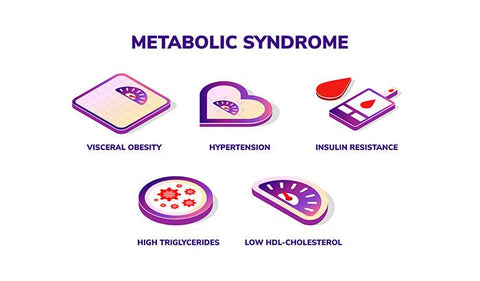Eating healthy meals isn’t always easy in our fast-paced world, but meal prepping makes it a bit easier.
Whether you're a busy professional juggling a hectic schedule, a parent trying to feed a family on the go, or simply someone looking to bring more structure and health to your eating habits, this blog is for you.
We understand that transitioning to a meal-prep lifestyle can be daunting, filled with challenges ranging from time constraints to maintaining variety in your diet. That's why we've put together this all-encompassing meal-prepping guide.
Here, you'll discover practical, easy-to-implement strategies that simplify the meal planning process, break down the art of meal preparation, and show you how to make it an enjoyable part of your routine. So, let’s embark on this journey to a healthier, more organized, and deliciously fulfilling way of eating!
The basics of meal planning
Meal planning is a proactive approach to organizing healthy meals for a set period — be it a week, fortnight, or month. It's about deciding in advance what you're going to eat, ensuring you have the necessary ingredients, and, often, preparing some or all of those meals ahead of time. The goal is to eat healthy meals, reduce food waste, and take the daily guesswork out of eating.
Key components of meal planning
Menu creation: This involves selecting recipes or meal ideas for each day's breakfast, lunch, dinner, and possibly snacks. It's the blueprint of your dietary intake for the selected period.
Grocery list preparation: Based on the menu, you compile a list of all the ingredients you need. This helps with efficient shopping, ensuring you have everything you need while avoiding unnecessary purchases.
Meal preparation: This can range from full meal prepping (cooking meals in advance) to simply prepping ingredients (like chopping vegetables) to make cooking easier and quicker during the week.
Portioning and storage: For those who cook in advance, portioning out meals into individual servings and storing them properly will help maintain freshness and ensure ease of use.
The importance of balance in meal prepping and planning
Balanced meal planning means incorporating a variety of food groups to meet nutritional needs. It should ideally include:
Proteins are essential for muscle repair and growth. Include lean meats, fish, eggs, or plant-based proteins like beans and lentils.
Carbohydrates: They are the body's primary energy source. Opt for complex carbs like whole grains, fruits, and vegetables rather than refined carbs.
Fats are necessary for nutrient absorption and brain health. Include sources of healthy fats like avocados, nuts, seeds, and olive oil.
Fruits and vegetables are packed with vitamins, minerals, and fiber, all of which you need for overall health and well-being.
One way WiO SmartFoods provides balance is by blocking 100% of the fats and 85% of the carbs contained in our food, so you can focus on eating healthy fats throughout your day. Fruits have natural sugars, so keep that in mind as you work toward a balanced diet.
Tips for setting realistic meal planning goals
Assess dietary needs: Consider any specific dietary requirements you have — whether they're calorie-controlled for weight loss, low-carb for diabetes management, or any food allergies or intolerances.
Consider your schedule: Be realistic about the time you have to dedicate to cooking. Plan simpler meals or consider batch cooking if you have a busy week ahead.
Start small: If you're new to meal planning, start with planning a few days at a time rather than an entire week or month.
Flexibility is key: Have some flexible options in your plan. For instance, having ingredients for a couple of quick backup meals is helpful if your schedule changes unexpectedly.
Involve family members: If you're meal prepping for a family, involve them in the process. This will make mealtime more enjoyable and ensure everyone's preferences are considered.
Review and adjust: Regularly review your meal plan to see what's working and what's not. Your meal plan should evolve with your changing lifestyle and preferences.
By understanding and implementing these aspects of meal planning, you’ll create a structured, yet flexible approach to eating that supports your health goals and fits into your lifestyle. This organized approach to food saves you time and money, reduces stress, and helps ensure a well-rounded, nutritious diet.
Getting started with meal planning
Starting with meal planning can seem daunting, but it's essentially about breaking the process down into manageable steps. By following a systematic approach, you’ll be able to create a meal plan that's both enjoyable and tailored to your lifestyle. Here’s a step-by-step guide to get you started:
Assess your weekly schedule
Look at the week ahead. Consider your work schedule, social commitments, and any other time constraints. Identify which days will require quicker meals or possibly eating out and which days you'll have more time to cook.
Select recipes
Choose recipes based on your schedule. Consider the nutritional balance of the recipes. Aim for the right mix of protein, carbs, and fats, and include a variety of vegetables.
Consider portion sizes
Think about portion sizes based on your dietary needs. This is particularly important if you’re meal-prepping for weight loss or specific health goals. Remember that portion sizes vary based on individual needs.
Make a grocery list
Based on your selected recipes, list out all the ingredients you’ll need. To streamline your shopping, organize your list by grocery store sections (produce, dairy, meats, pantry items).
Set aside time to prep
Choose a day for grocery shopping and a day for meal prep. For many, this might be over the weekend, but pick what works best for you. If you’re preparing meals in advance, consider storage. You’ll need enough containers and fridge/freezer space.
Prep and cook
Prepare ingredients in advance — wash and chop veggies, marinate proteins, or pre-cook certain items. Cook meals that are stored well in advance, or at least get a head start on meals for the next few days.
The importance of variety
Nutritional balance
A variety of foods ensures a range of essential nutrients. Different foods offer different vitamins, minerals, and other nutrients.
Avoiding meal fatigue
Eating the same meals repeatedly leads to boredom, often referred to as meal fatigue. Variety keeps meals exciting and enjoyable. One way to avoid meal fatigue and stay healthy with a busy schedule is by eating healthy, pre-cooked meals that are low-carb, fat-free, and high in protein. WiO SmartFoods provides exactly that with our diverse menu full of yummy options.

Catering to different tastes and preferences
If you’re meal planning for a family or a group, variety caters to different tastes and dietary preferences.
Seasonal and fresh ingredients
Incorporating a variety of foods allows you to use seasonal produce, which is often fresher and more flavorful.
Essential tools for effective meal prep
Equipping your kitchen with the right tools will transform meal prepping from a chore into an efficient, even enjoyable process. Here's a rundown of essential tools that will make your meal preparation effective and easier:
-
Quality knives: A sharp chef's and paring knives are fundamental. They make chopping, slicing, and dicing safer and more efficient.
-
Cutting boards: Have a couple of sturdy cutting boards — one for produce and another for meats to avoid cross-contamination.
-
Measuring cups and spoons: Essential for accuracy, especially when following recipes or tracking portion sizes for dietary goals.
-
Food processor or blender: These appliances are time-savers for chopping vegetables and making sauces, dressings, or smoothies.
-
Mixing bowls: A set of mixing bowls in various sizes is invaluable for mixing ingredients, marinating meats, or temporarily storing prepped food.
-
Storage containers: Invest in a good set of food storage containers, preferably glass. Having a variety of sizes for different meal components is helpful.
-
Non-stick skillets and pots: Non-stick cookware makes cooking and cleanup much easier. A large skillet and a couple of pots (small and large) should cover most cooking needs.
-
Baking sheets and pans: For oven cooking, roasting vegetables, and baking, a couple of baking sheets and roasting pans are essential.
- Slow cooker or instant pot: These are great for set-it-and-forget-it meals, especially when time is limited. They're perfect for stews, soups, and tender meats.
Smart grocery shopping strategies
Smart grocery shopping is key to successful meal planning and preparation. It’s not about what you buy, but how you buy. Here are strategies to make your grocery shopping efficient, cost-effective, and aligned with your health goals:
Plan ahead: Before heading to the store, plan your meals for the week and make a detailed shopping list. This helps avoid impulse buys and ensures you get everything you need.
Shop with a full stomach: Grocery shopping on an empty stomach might lead to impulsive decisions driven by hunger, often resulting in less healthy choices. We’re all about healthy meals here!
Stick to your list: Be disciplined about buying only what’s on your list. This helps resist the temptation to buy unhealthy foods and keeps your grocery bill in check.
Navigate the store wisely: Most fresh, whole foods are located around the perimeter of the store. Start there before moving to the inner aisles for pantry staples.
Read labels: Pay attention to food labels and ingredients, especially if you’re following a specific diet. Look for items with a short list of recognizable ingredients.
Buy seasonal produce: Seasonal fruits and vegetables are usually fresher, tastier, and more affordable. They also add variety to your diet throughout the year.
Consider bulk buying: For non-perishable items or foods you eat regularly, buying in bulk saves money. However, be mindful of storage space and usage.
Choose whole foods: Focus on minimally processed foods for better nutrition. This includes whole grains, lean proteins, fruits, and vegetables.
Be flexible with brands: Be open to trying store brands, which are often less expensive than name brands and often similar in quality.
Adapting meal plans for dietary restrictions
Adapting meals to dietary restrictions is essential in today's diverse dietary landscape, where allergies, intolerances, lifestyle choices, and health conditions dictate many people's eating habits. Whether you're cooking for yourself or others, here's how to modify meals to accommodate various dietary needs:
Common dietary restrictions
Allergies and intolerances: Common allergens include dairy, nuts, gluten, and shellfish. You’ll also want to consider intolerances, like lactose.
Vegetarian and vegan diets: These diets exclude certain animal products. Vegans avoid all animal-derived products, while vegetarians may consume dairy and eggs.
Low-carb and keto diets: Focus on reducing carbohydrates, often for weight loss or managing diabetes.
Other health-related diets might include low-sodium for heart health, anti-inflammatory diets, or low-FODMAP for digestive issues.
Adapting recipes
Ingredient substitutions
Gluten-free: Use gluten-free flour, pasta, and soy sauce. Ensure that all packaged ingredients are labeled gluten-free.
Dairy-free: Substitute dairy with plant-based milk, vegan cheese, and butter alternatives.
Nut allergies: Use pumpkin or sunflower seeds as replacements. Nut-free butter is also a good option.
Vegetarian/vegan: Replace meat with plant-based proteins like tofu, tempeh, legumes, or specialized vegetarian products.
Cooking techniques
Separate preparation areas: Use separate utensils and cutting boards to avoid cross-contamination, especially for allergies.
Cook in stages: If you’re preparing a dish that you can make with or without a certain ingredient, cook the base first, then separate it into portions before adding the restricted ingredient.
Flavor adjustments: When removing a major ingredient, compensate by enhancing other flavors through herbs, spices, or alternative ingredients that fulfill a similar role (e.g., umami flavor from mushrooms in place of meat).
Meal prepping healthy meals with WiO SmartFoods
And there you have it — a treasure trove of insights and strategies to elevate your meal planning and prepping game! But why stop here? To truly revolutionize your mealtime experience, we invite you to incorporate WiO SmartFoods into your culinary repertoire.
With our range of nutritious, low-carb, and tantalizing options, WiO SmartFoods is your ideal partner in the journey towards healthier eating.
Whether you're crafting a quick breakfast, packing a lunch, or prepping a family dinner, our products are designed to fit seamlessly into your meal plans, adding both convenience and taste. From our kitchen to yours, we bring a variety of choices that cater to diverse palates and dietary needs, making healthy eating both simple and enjoyable.
So, why wait? Elevate your meal prep today with WiO SmartFoods. Dive into our collection, explore our delicious options, and discover how we can help transform your meal planning from a task into a delightful experience. Happy meal prepping, and here’s to a journey of health, flavor, and convenience with WiO SmartFoods! 🌱🥘🛒🌟







